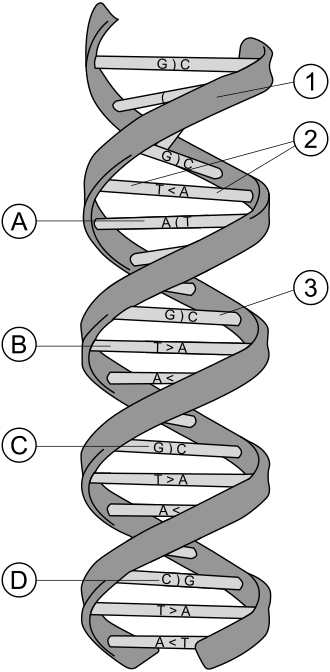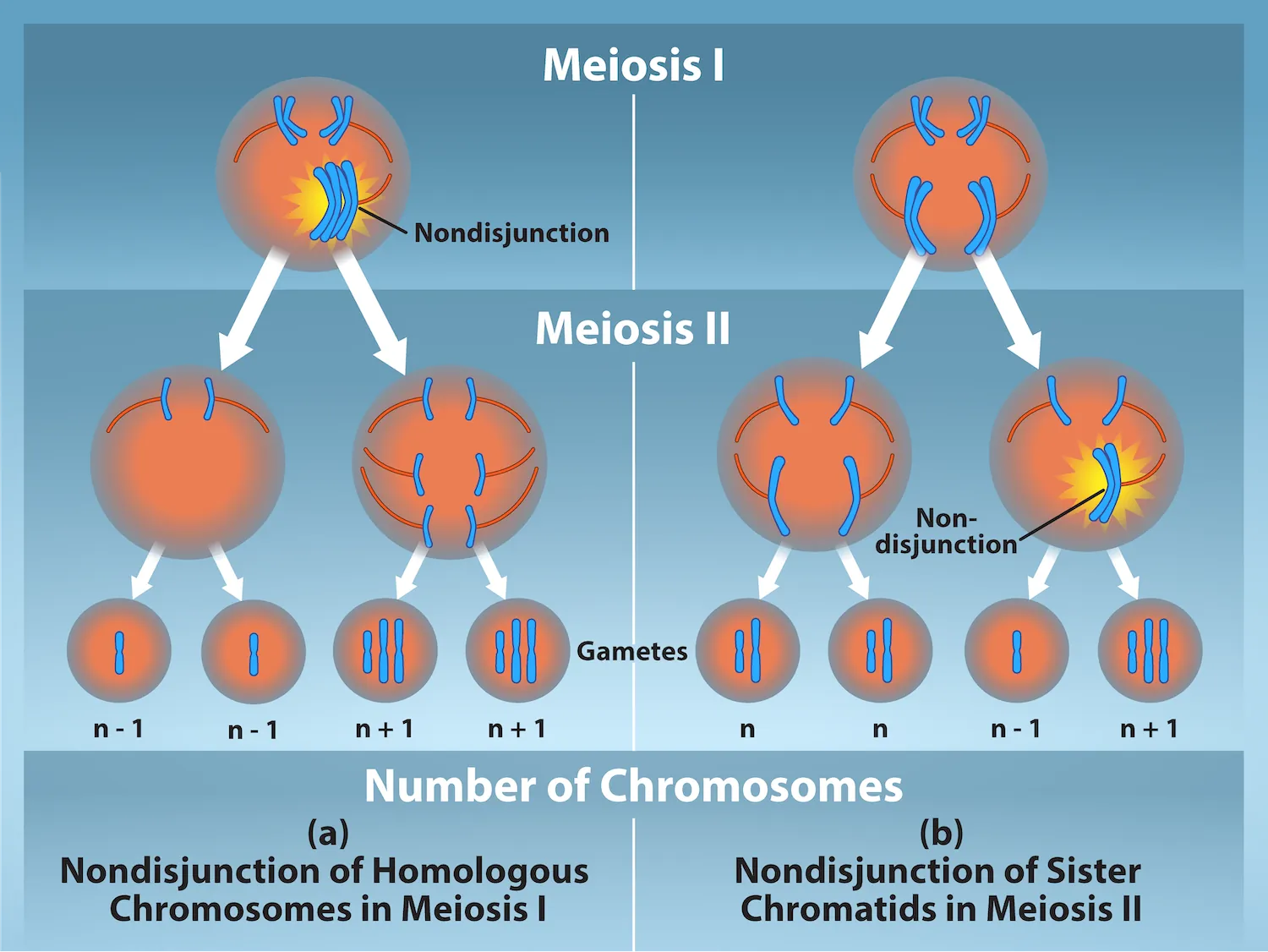IB Syllabus focus:
'- DNA, genes, and chromosomes
- Genetic mutations and their implications
- Heredity and genetic disorders'
The intricate tapestry of life is woven with threads of genetic information. By understanding the fundamentals of genetics, including DNA, genes, and chromosomes, we gain insights into the blueprint that shapes living organisms. Moreover, exploring the realm of genetic mutations reveals how subtle changes in this blueprint can have profound implications for behaviour, health, and disorders.
DNA: The Blueprint of Life
Deoxyribonucleic Acid (DNA): This is the molecule at the heart of all genetic processes, steering the growth, development, functioning, and reproduction of all known living organisms.
Structure: DNA adopts a twisted ladder or double helix shape. The sides of this ladder are made up of sugar and phosphate molecules, while its rungs consist of pairs of four types of molecules called nucleotide bases.
Components: The nucleotide bases, the core of DNA's information storage, are adenine (A), thymine (T), guanine (G), and cytosine (C). These bases pair in a specific manner: A with T and G with C.

Diagram of a short stretch of DNA showing the sugar-phosphate backbone and complementary base pairs (A–T and G–C). The labels match the terminology used in the syllabus (base pair, nitrogenous base, backbone). Source.Function: Acting as an instruction manual, DNA sequences determine how organisms are built and function. From eye colour to susceptibility to certain diseases, DNA plays a role in defining various aspects of an individual. Understanding the localisation of function in the brain further complements our comprehension of how genetic information is expressed in complex behaviours and traits.
Genes: Units of Heredity
Definition: A gene represents a distinct sequence of nucleotides forming part of a chromosome. It is the fundamental physical and functional unit of heredity.
Location: Genes occupy specific locations on a chromosome. These locations are called loci.
Variability: Different versions or variants of genes are called alleles. These alleles can lead to different observable properties, like variations in eye or hair colour.
Expression: Genes orchestrate the synthesis of proteins, the workhorses of cells, executing various functions. Whether a gene is switched 'on' or 'off' influences traits and features of an organism. The fascinating dynamics between nature vs. nurture underscore the complex interplay between genetics and the environment in shaping an individual.
Chromosomes: DNA Storage
Definition: Think of chromosomes as DNA libraries. They are long DNA molecules packed with part or all of the genetic material of an organism.
Composition: By coiling around protein molecules, particularly histones, DNA can fit into the cell nucleus as compact chromosomes.
Human Cells: A typical human cell comprises 46 chromosomes, grouped into 23 pairs. Among these, one pair determines the sex of an individual – termed the sex chromosomes (X and Y).
Karyotype: A visual profile of all the chromosomes in a cell, a karyotype can be a powerful tool for identifying genetic disorders stemming from chromosome abnormalities. he study of twin studies further enriches our understanding of genetic influence versus environmental factors on human development.

Standard human karyotype arranged by size and centromere position, showing 22 homologous autosome pairs and the XX sex chromosomes. Such karyograms are used to detect aneuploidies and large structural changes. Source.
Genetic Mutations: Variations and Implications
Definition: In the world of genetics, not everything is static. Mutations refer to any change in the DNA sequence, and they can have varied effects on an individual.
Types:
Point mutations: These occur when a single nucleotide base is added, removed, or substituted. Such a tiny change can sometimes have a substantial impact.
Insertions and Deletions: Here, nucleotides are either added to or removed from a gene. This can disrupt the reading frame, leading to improperly formed proteins.
Chromosomal alterations: Sometimes, larger chunks of DNA can be lost, rearranged, or duplicated, affecting many genes at once.
Causes:
Spontaneous mutations: Random errors during DNA replication can lead to mutations. These errors are usually corrected, but occasionally, they persist.
Induced mutations: These mutations are brought about by external agents like radiation or chemicals that interfere with DNA.
Implications:
Beneficial mutations: Some mutations can give the organism a survival edge, leading to evolutionary advancements.
Neutral mutations: Many mutations are neither helpful nor harmful. They may become significant in future generations.
Harmful mutations: These can result in malfunctions in body systems or lead to genetic disorders. The exploration of neuroplasticity reveals how the brain's structure and function can be affected by environmental changes, including the impact of genetic mutations.
Heredity: Passing on Traits
Definition: Heredity is nature's way of passing on traits from one generation to the next. It’s the reason offspring resemble their parents.
Mendelian Genetics: Pioneered by Gregor Mendel, this area of genetics focuses on the inheritance of single-gene traits. Mendel used pea plants to establish the laws of inheritance, setting the foundation for modern genetics.
Phenotype vs. Genotype: While a phenotype refers to observable characteristics (like height and hair colour), a genotype pertains to the set of genes responsible for a particular trait.
Dominant and Recessive: Not all alleles have an equal say in determining a trait. Dominant alleles mask the presence of recessive ones. For a recessive trait to manifest, both alleles must be recessive.
Genetic Disorders: When Things Go Wrong
Definition: Genetic disorders arise from anomalies in an individual's DNA. They can be inherited or result from a mutation.
Types:
Monogenic disorders: Originating from mutations in a single gene, they include conditions like cystic fibrosis and haemophilia.
Chromosomal disorders: Issues in chromosome number or structure can lead to disorders like Down syndrome or Turner syndrome.

Illustration of nondisjunction during meiosis I versus meiosis II, yielding gametes with n+1 or n–1 chromosomes; fertilization can produce trisomic or monosomic zygotes. This directly explains the origin of aneuploid conditions named in the syllabus. Source.
Complex disorders: Conditions like diabetes or heart disease can arise from the interplay of mutations in several genes, often coupled with environmental factors.
Diagnosis and Treatment:
Prenatal testing: Techniques like amniocentesis allow detection of genetic abnormalities in foetuses.
Gene therapy: A frontier in medical science, gene therapy aims to treat or prevent disease by modifying or replacing defective genes. The ethical landscape surrounding genetics, especially in the realm of ethical considerations in animal studies, is critical for guiding responsible research practices.
As we traverse further into the intricate landscape of genetics and behavioural traits, understanding these basics provides a solid foundation to appreciate the complex interplay between genes, environment, and behaviour.
FAQ
Recessive genetic disorders occur when an individual inherits two copies of a mutated gene, one from each parent. The reason these disorders are recessive is rooted in the dynamics of dominant and recessive alleles. If a person inherits a healthy allele (dominant) from one parent and a mutated allele (recessive) from the other, the dominant allele's function often compensates for the faulty one, preventing the disorder. It's only when both alleles are mutated (and hence recessive) that there isn't a functioning backup, leading to the manifestation of the genetic disorder.
Genes determine an individual's traits by coding for specific proteins. These proteins play a variety of roles, from forming the structure of our bodies to regulating bodily processes. The sequence of nucleotide bases in a gene dictates the sequence of amino acids in a protein, which in turn determines its shape and function. While genes provide the blueprint, the expression of these genes can be influenced by environmental factors, leading to varied outcomes. Over time, some gene expressions can change due to factors like age, exposure to environmental toxins, or other external influences, leading to alterations in traits or the onset of certain genetically-predisposed conditions.
Behavioural traits are often the result of a complex interplay between genetics and the environment. While genes provide the underlying code, environmental factors can influence how these genes are expressed. For instance, a person might have a genetic predisposition for anxiety, but whether or not they develop an anxiety disorder might hinge on environmental factors like trauma or upbringing. By examining both genetics and environment, researchers can gain a holistic understanding of behavioural traits, paving the way for more effective interventions and treatments.
Absolutely, mutations can be beneficial. While often associated with disorders or malfunctions, mutations are simply changes in the DNA sequence. These changes can introduce variability in a population, and if a mutation offers a survival or reproductive advantage, it can become more prevalent over generations. For example, a mutation granting resistance to a particular disease would be beneficial in an environment where that disease is prevalent. Over time, this mutation could spread through natural selection, as individuals with the mutation might have a higher chance of surviving and reproducing. This process forms the crux of evolutionary adaptation.
The structure of DNA is famously described as a double helix, resembling a twisted ladder. This specific shape is crucial for its function. The "rungs" of the ladder are composed of pairs of nucleotide bases, which store genetic information. The sequence of these bases determines the genetic instructions for building and maintaining the organism. The double-stranded design ensures the stability of genetic data, providing a backup copy. During replication, each strand serves as a template, ensuring accurate transmission of genetic information. The twisted helical structure also aids in the efficient packing of DNA within the cell nucleus.
Practice Questions
The phenotype and genotype are central concepts in genetics. A genotype refers to the genetic makeup or the specific set of genes that an individual possesses. For instance, if an individual has alleles for blue eyes, that’s their genotype. On the other hand, phenotype refers to the observable characteristics or traits as a result of the interaction between those genes and the environment. The blue eye colour that we can see is the phenotype. It’s worth noting that while genotype is a direct reflection of inherited information, phenotype can be influenced by both genetic and environmental factors.
Genetic mutations refer to any changes in the DNA sequence. These changes can be due to errors during DNA replication or exposure to external agents like radiation. Mutations can be beneficial, neutral, or harmful. Behavioural traits, like all traits, are influenced by genes, and mutations in these genes can potentially alter behaviour. For example, a mutation in a gene that affects neurotransmitter production or receptor sensitivity could influence behaviour traits, such as mood or temperament. Harmful mutations might lead to disorders that have behavioural implications, like Fragile X syndrome, which can result in intellectual disabilities and specific behavioural patterns.

